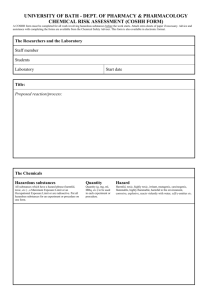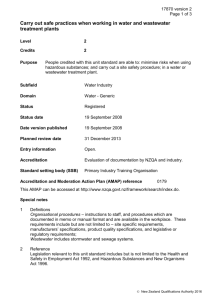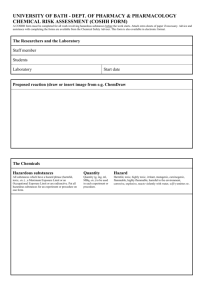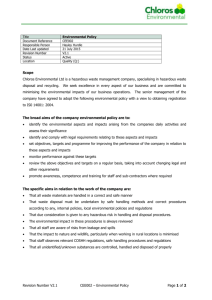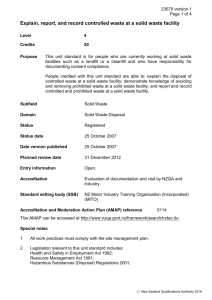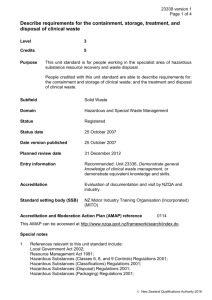23338 Demonstrate knowledge of documentation for final
advertisement
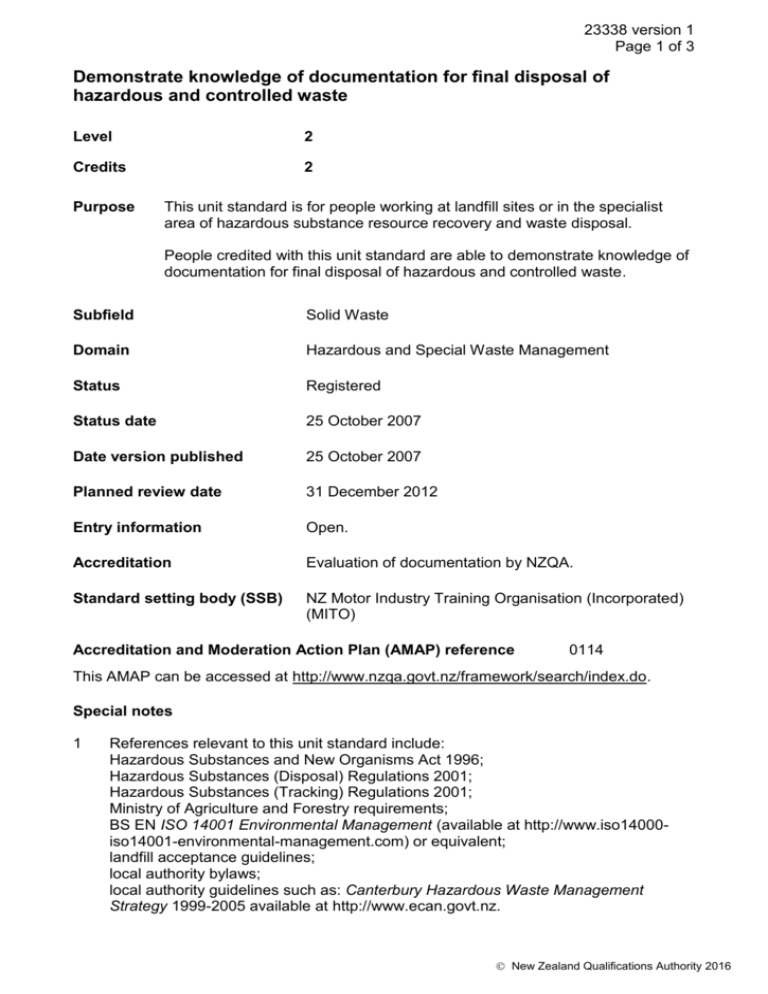
23338 version 1 Page 1 of 3 Demonstrate knowledge of documentation for final disposal of hazardous and controlled waste Level 2 Credits 2 Purpose This unit standard is for people working at landfill sites or in the specialist area of hazardous substance resource recovery and waste disposal. People credited with this unit standard are able to demonstrate knowledge of documentation for final disposal of hazardous and controlled waste. Subfield Solid Waste Domain Hazardous and Special Waste Management Status Registered Status date 25 October 2007 Date version published 25 October 2007 Planned review date 31 December 2012 Entry information Open. Accreditation Evaluation of documentation by NZQA. Standard setting body (SSB) NZ Motor Industry Training Organisation (Incorporated) (MITO) Accreditation and Moderation Action Plan (AMAP) reference 0114 This AMAP can be accessed at http://www.nzqa.govt.nz/framework/search/index.do. Special notes 1 References relevant to this unit standard include: Hazardous Substances and New Organisms Act 1996; Hazardous Substances (Disposal) Regulations 2001; Hazardous Substances (Tracking) Regulations 2001; Ministry of Agriculture and Forestry requirements; BS EN ISO 14001 Environmental Management (available at http://www.iso14000iso14001-environmental-management.com) or equivalent; landfill acceptance guidelines; local authority bylaws; local authority guidelines such as: Canterbury Hazardous Waste Management Strategy 1999-2005 available at http://www.ecan.govt.nz. New Zealand Qualifications Authority 2016 23338 version 1 Page 2 of 3 2 Definitions Company procedures means the documented methods for performing work activities and include health and safety, environmental, and quality management requirements. They may refer to manuals, codes of practice, or policy statements. Controlled waste refers to waste substances designated in a solid waste facility site management plan as prohibited or requiring special attention. Hazardous waste refers to waste that: Contains hazardous substances at sufficient concentrations to exceed the minimum degrees of hazard specified by Hazardous Substances (Minimum Degrees of Hazard) Regulations 2000, or Meets the definition for infectious substances included in the Land Transport Rule: Dangerous Goods 2005 and NZS 5433: 1999 Transport of Dangerous Goods on Land, or Meets the definition for radioactive material included in the Radiation Protection Act 1965 and Radiation Protection Regulations 1982. Elements and performance criteria Element 1 Demonstrate knowledge of documentation for final disposal of hazardous and controlled waste. Performance criteria 1.1 Ownership of and responsibility for waste is explained in accordance with legislation. Range 1.2 Wastes that require their destruction or disposal to be documented are identified in accordance with the Hazardous Substances (Tracking) Regulations 2001, Hazardous Substances (Disposal) Regulations 2001, bylaws, and site requirements. Range 1.3 Schedule 1 of the Hazardous Substances (Tracking) Regulations 2001, at least two bylaws, at least three site requirements. Details to be documented are described in relation to the type of waste disposal. Range 1.4 ownership and responsibility throughout lifecycle. includes but is not limited to – material type, material quantity, manufacturer’s name, date of manufacture, date of disposal, method of disposal, quantity disposed of. Requirements for completing destruction or disposal certificates are described in accordance with company procedures. New Zealand Qualifications Authority 2016 23338 version 1 Page 3 of 3 Please note Providers must be accredited by NZQA, or an inter-institutional body with delegated authority for quality assurance, before they can report credits from assessment against unit standards or deliver courses of study leading to that assessment. Industry Training Organisations must be accredited by NZQA before they can register credits from assessment against unit standards. Accredited providers and Industry Training Organisations assessing against unit standards must engage with the moderation system that applies to those standards. Accreditation requirements and an outline of the moderation system that applies to this standard are outlined in the Accreditation and Moderation Action Plan (AMAP). The AMAP also includes useful information about special requirements for organisations wishing to develop education and training programmes, such as minimum qualifications for tutors and assessors, and special resource requirements. Comments on this unit standard Please contact the NZ Motor Industry Training Organisation (MITO) info@mito.org.nz if you wish to suggest changes to the content of this unit standard. New Zealand Qualifications Authority 2016


